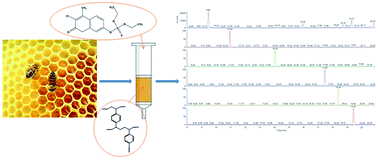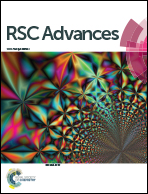Trace determination of acaricides in honey samples using XAD-2 adsorbent and gas chromatography coupled with an ion trap mass spectrometer detector†
Abstract
Various infectious/parasitic diseases affect beekeeping (e.g., Varroa destructor) and substances like acaricides are largely used as pesticides to tackle this problem, in particular tau-fluvalinate, fipronil, bromopropylate, amitraz, and coumaphos. A key issue in their use though is potential ingress into the human food chain, and in this regard accurate residue determination of such compounds in honey foods at trace concentration levels is critical. This paper describes an analytical methodology for determining qualitatively and quantitatively the acaricide residues in such foods. A solid-phase extraction method has been developed for the extraction and analysis of five acaricides in honey-foods using XAD-2 sorbent. Gas Chromatography coupled with an Ion Trap Mass Spectrometer detector (GC-IT/MS) was used for the analysis. The isotherm and breakthrough curves for XAD-2 solution are reported here. The developed procedure allows efficient acaricide recoveries, ranging from 81–96% with relative standard deviations (RSDs) of ≤6.9 for honey-food samples. The linearity (R2) of each acaricide has been investigated in the range 0.030–10.0 μg g−1 for evaluating the whole analytical protocol, R2 values are ≥0.945. The intraday and interday repeatabilities for honey samples were between 4.1–9.2 and 2.4–5.6, respectively. Special note has been made to the determination of the Limits of Detection (LODs) and the Limits of Quantification (LOQs) and their relative comparison with those reported in literature and those in International regulations: for GC/IT-MS (SIM mode), LODs vary between 3 ng g−1 and 18 ng g−1 (RSD ≤ 4.9), whereas LOQs range between 8 ng g−1 and 48 ng g−1 (RSD ≤ 8.3). The analytical method developed here has been applied to several commercial honey-foods (Millefiori, molasses, royal jelly). The investigated method is simple, selective, reproducible, reliable, and inexpensive.


 Please wait while we load your content...
Please wait while we load your content...